这一阵子没有更新文章,虽说也没啥人看吧,但是还是给有可能看的读者说声抱歉,最近心情不太好,
力扣刷题虽然也在持续的刷着,但是没啥感觉了,所以也就没有将他们转换成博客的想法,有可能是一个刚开始的瓶颈期吧,等回头突破了这段瓶颈期,
我再写一些力扣的文章。
一切都是为了live||life whatever
so,我这一阵子还在学习了MyBatis的相关知识,在这里跟大家分享下,也算是做个总结吧。
所用到的源代码和建库脚本都在评论下方,以及本人资源当中,欢迎下载!!!
顺带说一句,想体验的话,代码最好自己手敲,看源代码跑一遍,没啥用,我们要动手,从实践中获得真知,但是数据库就没必要自己建立了。那数据好几千条我们手动造数据吗?
对吧。
=分隔符=
关于MyBatis是一个Java里面的框架
至于什么是框架,咋用的?到底是个什么东西,这玩意困惑了我好久。
何为框架Framework
????
框架是可被应用开发中定制的应用骨架
框架是一种规则,保证开发者遵循相同的方式开发程序
框架提倡“不要重复造轮子”,对基础功能进行封装
(扯犊子的理论)
框架的优点:
极大提高了开发效率
统一的编码规则,利于团队管理
灵活配置的应用,拥有更好的维护性
(最坑爹的东西,因为要背)
SSM开发框架:
Spring 框架的框架,职责是对系统中各个对象进行有效的管理
Spring MVC 替代servlet更有效的web开发,职责是替代Servlet,进行web层面的开发。
MyBatist 简化数据库的交互ORM框架
(好牛掰啊)
什么是MyBatis?
MyBatis是优秀的持久层框架,持久就是将内存的数据保存到数据库中防止丢失
MyBatis通过xml将SQL与程序解耦,便于维护
MyBatis学习简单,执行高效,是JDBC的延伸,在JDBC的基础上进行扩展和封装
(说那么多就是个可以使连接数据库,对数据库在程序中进行操作的一个库而已。)
MyBatis开发流程
引入MyBatis依赖(利用Maven自动下载MyBatis核心jai包)
创建核心配置文件(基于XML进行配置管理的)
创建实体(Entity)类/域对象/pojo(将数据表和类进行一一对应,表字段和类属性一一对应)
创建Mapper映射文件(通过此文件设置哪个表和哪个类对应,哪个字段和哪个属性对应)
初始化SessionFactory(读取配置文件,做好Mapper映射,做前期准备)
利用SqlSession对象操作数据
OK,开始第一步实操的准备工作,我们需要完成创建Maven工程

下一步

下一步

完成
结果如下:
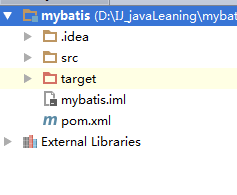
然后我们在将文件夹结构创建下。
具体如图:
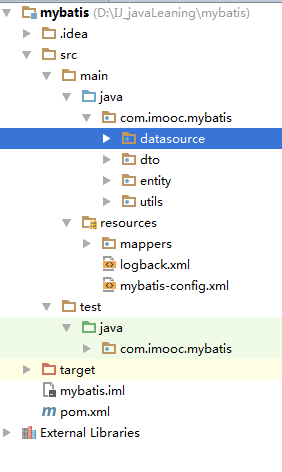
接下来需要建库数据库:
具体的数据库脚本和数据都在文章开头说的地方,在这里列出来数据库的大致效果
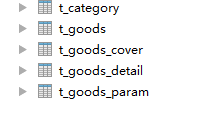
一共四张表
每张表的内容是





接下来我们做真正的第一步
引入MyBatis依赖以及其他我们需要用到的包
我们在pom.xml文件中输入如下内容,pom文件刚开始开头的内容和我的不同的话,不要修改,那是自动生成和你的项目对应的,不能乱改,不然会报错。
<?xml version="1.0" encoding="UTF-8"?>
<project xmlns="http://maven.apache.org/POM/4.0.0"
xmlns:xsi="http://www.w3.org/2001/XMLSchema-instance"
xsi:schemaLocation="http://maven.apache.org/POM/4.0.0 http://maven.apache.org/xsd/maven-4.0.0.xsd">
<modelVersion>4.0.0</modelVersion>
<groupId>com.imooc</groupId>
<artifactId>mybatis</artifactId>
<version>1.0-SNAPSHOT</version>
<dependencies>
<dependency>
<groupId>org.mybatis</groupId>
<artifactId>mybatis</artifactId>
<version> 3.5.1</version>
</dependency>
<dependency>
<groupId>junit</groupId>
<artifactId>junit</artifactId>
<version>4.12</version>
<scope>test</scope>
</dependency>
<dependency>
<groupId>mysql</groupId>
<artifactId>mysql-connector-java</artifactId>
<version>5.1.47</version>
</dependency>
<dependency>
<groupId>ch.qos.logback</groupId>
<artifactId>logback-classic</artifactId>
<version>1.2.3</version>
</dependency>
<dependency>
<groupId>com.github.pagehelper</groupId>
<artifactId>pagehelper</artifactId>
<version>5.1.10</version>
</dependency>
<dependency>
<groupId>com.github.jsqlparser</groupId>
<artifactId>jsqlparser</artifactId>
<version>2.0</version>
</dependency>
<dependency>
<groupId>com.mchange</groupId>
<artifactId>c3p0</artifactId>
<version>0.9.5.4</version>
</dependency>
</dependencies>
</project>
2、接下来我们在
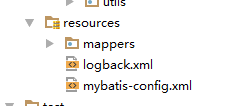
创建myba-config.xml即MyBatis的核心配置文件
具体内容如下:按照你自己的实际情况输入配置文件的密码哈,别照抄,所用的的数据库文件,我会放在文章尾部评论的位置。
<?xml version="1.0" encoding="UTF-8" ?>
<!DOCTYPE configuration
PUBLIC "-//mybatis.org//DTD Config 3.0//EN"
"http://mybatis.org/dtd/mybatis-3-config.dtd">
<configuration>
<settings>
<!--goods_id===>goodsId驼峰命名转换-->
<setting name="mapUnderscoreToCamelCase" value="true"/>
</settings>
<!--启用PageHelper分页插件-->
<plugins>
<plugin interceptor="com.github.pagehelper.PageInterceptor">
<!--设置数据库类型-->
<property name="helperDialect" value="mysql"/>
<!---分页合理化-->
<property name="reasonable" value="true"/>
</plugin>
</plugins>
<!--设置默认指向的数据库-->
<environments default="dev">
<!--配置环境,不同的环境用不同的id名字-->
<environment id="dev">
<!--采用jdbc的方式对数据库事物进行commit、rollback-->
<transactionManager type="JDBC"/>
<!--采用连接池的方式管理数据库-->
<!--<dataSource type="POOLED">-->
<dataSource type="com.imooc.mybatis.datasource.C3P0DataSourceFactory">
<property name="driverClass" value="com.mysql.jdbc.Driver"/>
<property name="jdbcUrl" value="jdbc:mysql://localhost:3306/babytun?useUnicode=true&characterEncoding=UTF-8"/>
<property name="user" value="root"/>
<property name="password" value="root"/>
<property name="initialPoolSize" value="5"/>
<property name="maxPoolSize" value="20"/>
<property name="minPoolSize" value="5"/>
</dataSource>
</environment>
<environment id="prd">
<!--采用jdbc的方式对数据库事物进行commit、rollback-->
<transactionManager type="JDBC"/>
<!--采用连接池的方式管理数据库,&在xml中有意义,若要使用加上amp;-->
<dataSource type="POOLED">
<property name="driver" value="com.mysql.jdbc.Driver"/>
<property name="url" value="jdbc:mysql://localhost:3306/babytun?useUnicode=true&characterEncoding=UTF_8"/>
<property name="username" value="root"/>
<property name="password" value="root"/>
</dataSource>
</environment>
</environments>
<mappers>
<mapper resource="mappers/goods.xml"></mapper>
<mapper resource="mappers/goods_detail.xml"></mapper>
</mappers>
</configuration>
3、创建实体(Entity)类/域对象/pojo(将数据表和类进行一一对应,表字段和类属性一一对应)

这三个都是我们以后会用得到的实体,先一次性创建完吧。
代码如下:
public class Category {
private Integer categoryId;
private String categoryName;
private Integer parentId;
private Integer categoryLevel;
private Integer categoryOrder;
@Override
public String toString() {
return "Category{" +
"categoryId=" + categoryId +
", categoryName='" + categoryName + '\'' +
", parentId=" + parentId +
", categoryLevel=" + categoryLevel +
", categoryOrder=" + categoryOrder +
'}';
}
public Integer getCategoryId() {
return categoryId;
}
public void setCategoryId(Integer categoryId) {
this.categoryId = categoryId;
}
public String getCategoryName() {
return categoryName;
}
public void setCategoryName(String categoryName) {
this.categoryName = categoryName;
}
public Integer getParentId() {
return parentId;
}
public void setParentId(Integer parentId) {
this.parentId = parentId;
}
public Integer getCategoryLevel() {
return categoryLevel;
}
public void setCategoryLevel(Integer categoryLevel) {
this.categoryLevel = categoryLevel;
}
public Integer getCategoryOrder() {
return categoryOrder;
}
public void setCategoryOrder(Integer categoryOrder) {
this.categoryOrder = categoryOrder;
}
}
public class Goods {
private Integer goodsId;//商品编号
private String title;//标题
private String subTitle;//子标题
private Float originalCost;//原始价格
private Float currentPrice;//当前价格
private Float discount;//折扣率
private Integer isFreeDelivery;//是否包邮1包邮0不包邮
private Integer categoryId;//分类编号
private List<GoodsDetail> goodsDetails;
public List<GoodsDetail> getGoodsDetails() {
return goodsDetails;
}
public void setGoodsDetails(List<GoodsDetail> goodsDetails) {
this.goodsDetails = goodsDetails;
}
public Integer getGoodsId() {
return goodsId;
}
@Override
public String toString() {
return "Goods{" +
"goodsId=" + goodsId +
", title='" + title + '\'' +
", subTitle='" + subTitle + '\'' +
", originalCost=" + originalCost +
", currentPrice=" + currentPrice +
", discount=" + discount +
", isFreeDelivery=" + isFreeDelivery +
", categoryId=" + categoryId +
'}';
}
public void setGoodsId(Integer goodsId) {
this.goodsId = goodsId;
}
public String getTitle() {
return title;
}
public void setTitle(String title) {
this.title = title;
}
public String getSubTitle() {
return subTitle;
}
public void setSubTitle(String subTitle) {
this.subTitle = subTitle;
}
public Float getOriginalCost() {
return originalCost;
}
public void setOriginalCost(Float originalCost) {
this.originalCost = originalCost;
}
public Float getCurrentPrice() {
return currentPrice;
}
public void setCurrentPrice(Float currentPrice) {
this.currentPrice = currentPrice;
}
public Float getDiscount() {
return discount;
}
public void setDiscount(Float discount) {
this.discount = discount;
}
public Integer getIsFreeDelivery() {
return isFreeDelivery;
}
public void setIsFreeDelivery(Integer isFreeDelivery) {
this.isFreeDelivery = isFreeDelivery;
}
public Integer getCategoryId() {
return categoryId;
}
public void setCategoryId(Integer categoryId) {
this.categoryId = categoryId;
}
}
public class GoodsDetail {
private Integer gdId;
private Integer goodsId;
private String gdPicUrl;
private Integer gdOrder;
private Goods goods;
public Goods getGoods() {
return goods;
}
public void setGoods(Goods goods) {
this.goods = goods;
}
public Integer getGdId() {
return gdId;
}
public void setGdId(Integer gdId) {
this.gdId = gdId;
}
public Integer getGoodsId() {
return goodsId;
}
public void setGoodsId(Integer goodsId) {
this.goodsId = goodsId;
}
public String getGdPicUrl() {
return gdPicUrl;
}
public void setGdPicUrl(String gdPicUrl) {
this.gdPicUrl = gdPicUrl;
}
public Integer getGdOrder() {
return gdOrder;
}
public void setGdOrder(Integer gdOrder) {
this.gdOrder = gdOrder;
}
}
4、创建Mapper映射文件(通过此文件设置哪个表和哪个类对应,哪个字段和哪个属性对应)
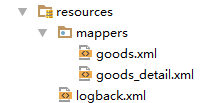
我们会创建这两个mapper,代码不慌给大家,我们接着来。
5、初始化SessionFactory(读取配置文件,做好Mapper映射,做前期准备)
这一步我们在测试类中完成,顺便也就检验了我们的项目到底成没成功的搭建呢???
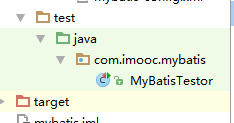
我们创建此类,并在该类中添加测试代码。以后叫其为测试类,我们所有的测试都放在这里,
接下来不会一次性把测试类的代码都给大家,而是需要一个(我们尝试在Mapper中添加一个数据库操作的时候),我们向测试类添加一个测试方法,来检测我们的数据库操作有没有成功!!
此处谨记
public class MyBatisTestor {
@Test
public void testSqlSessionFactory() throws IOException{
//利用Reader加载classpath下的MyBatis-config。XML核心配置文件
Reader reader= Resources.getResourceAsReader("mybatis-config.xml");
//初始化SQLSessionFactory对象,同时解析MyBatis-config。xml文件
SqlSessionFactory sqlSessionFactory=new SqlSessionFactoryBuilder().build(reader);
System.out.println("加载成功");
SqlSession sqlSession=null;
//创建SQLSession对象,SQLSession是JDBC的扩展类,用于与数据库交互
try {
sqlSession = sqlSessionFactory.openSession();
Connection connection = sqlSession.getConnection();
System.out.println(connection);
System.out.println("asdadadasdadas");
}catch (Exception e){
e.printStackTrace();
}finally {
if(sqlSession!=null){
sqlSession.close();
}
}
}
}
点击测试:

运行后结果如图:


OK我们现在看起来配置完成了,但是这样就OK了吗??
我们目前只能说我们的框架的结构搭起来了
但是我们难道每次运行MyBatis框架进行数据库连接的时候都需要那么长的代码吗?
我们可以借助JDBC开发的经验,开发一个工具类
于是我们在:
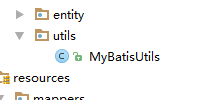
新建该工具类
然后具体代码:
以及测试该工具类的方法,记得放在上一步创建的测试类中哈
public class MyBatisUtils {
//利用static(静态)属于类不属于对象,且全局唯一
//static保证此属性属于类,而非对象
private static SqlSessionFactory sqlSessionFactory=null;
//利用静态块在初始化类时实例化SQLSessionFactory
static {
Reader reader=null;
try {
reader= Resources.getResourceAsReader("mybatis-config.xml");
sqlSessionFactory = new SqlSessionFactoryBuilder().build(reader);
}catch (IOException e){
e.printStackTrace();
//初始化错误时,通过抛出异常ExceptionInInitializerError通知调用者
throw new ExceptionInInitializerError(e);
}
}
/**
* 创建一个新的SQLSession对象
* @return SQLSession对象
*/
public static SqlSession openSession(){
//默认SQLSession是自动提交事务数据(commit)
//设置false代表关闭自动提交,改为手动提交事务数据
return sqlSessionFactory.openSession(false);
}
/**
* 释放一个有效的SQLSession对象
* @param session 准备释放SQLSession对象
*/
public static void closeSession(SqlSession session){
if(session!=null){
session.close();
}
}
}
@Test
public void testMyBatisUtils(){
SqlSession sqlSession=null;
try {
sqlSession = MyBatisUtils.openSession();
Connection connection = sqlSession.getConnection();
System.out.println("工具类成功");
System.out.println(connection);
MyBatisUtils.closeSession(sqlSession);
} catch (Exception e){
e.printStackTrace();
}finally {
MyBatisUtils.closeSession(sqlSession);
}
}
这样看来是不是简洁多了?
嗯,效果如图所示:

接下来就是
6、利用SqlSession对象操作数据
首先对于数据的操作是查询哦
查询步骤
1、 创建实体类Entity
2、 创建Mapper XML说明当前sql语句
3、 在MapperXML< select >SQL标签
4、 开启驼峰命名映射
5、 在MyBatis-config增加Mapper文件的声明
6、 SQLSession执行select语句
驼峰式命名我们在上面就开启啦,所以不用担心
我们打开Mapper包下面的goods.xml
然后在里面输入如下内容

<?xml version="1.0" encoding="UTF-8" ?>
<!DOCTYPE mapper
PUBLIC "-//mybatis.org//DTD Mapper 3.0//EN"
"http://mybatis.org/dtd/mybatis-3-mapper.dtd">
<mapper namespace="goods">
<select id="selectAll" resultType="com.imooc.mybatis.entity.Goods" useCache="false">
select *
from t_goods
order BY goods_id DESC limit 10
<!--单参数传递,使用parameterType指定参数的数据类型即可,SQL中#{VALUE }提取参数-->
<select id="selectById" parameterType="Integer" resultType="com.imooc.mybatis.entity.Goods">
SELECT *
from t_goods
where goods_id=#{VALUE }
</select>
<!--多参数传递时,使用parameterType 指定Map接口,SQL中#{key}提取参数-->
<select id="selectByPriceRange" parameterType="java.util.Map" resultType="com.imooc.mybatis.entity.Goods">
SELECT * FROM t_goods
where current_price BETWEEN #{min} and #{max}
order by current_price
limit 0,#{limit}
</select>
<!--利用linkedHashMap保存多表关联结果
MyBatis会将每一条记录包装为LinkedHashMap对象
key是字段名,value是字段对应的值,字段类型根据表结构进行自动判断
优点:易于扩展,易于使用
缺点:太过灵活,无法进行编译时检查
-->
<select id="selectGoodsMap" resultType="java.util.LinkedHashMap" flushCache="true">
select g.*,c.category_name,'1'as test
from t_goods g,t_category c
where g.category_id=c.category_id
</select>
<!-- 结果映射-->
<resultMap id="rmGoods" type="com.imooc.mybatis.dto.GoodsDTO">
<!-- 设置主键字段和属性的映射-->
<id property="goods.goodsId" column="goods_id" ></id>
<!-- 设置非主键字段和属性的映射-->
<result property="goods.title" column="title"></result>
<result property="goods.originalCost" column="original_cost"></result>
<result property="goods.currentPrice" column="current_price"></result>
<result property="goods.discount" column="discount"></result>
<result property="goods.isFreeDelivery" column="is_free_delivery"></result>
<result property="goods.categoryId" column="category_id"></result>
<result property="category.categoryId" column="category_id"></result>
<result property="category.categoryName" column="category_name"></result>
<result property="category.categoryLevel" column="category_level"></result>
<result property="category.categoryOrder" column="category_order"></result>
<result property="test" column="test"></result>
</resultMap>
<select id="selectGoodsDTO" resultMap="rmGoods">
select g.*,c.*,'1'as test
from t_goods g,t_category c
where g.category_id=c.category_id
</select>
</mapper>
好的,这一共是五个查询有关的方法
为了测试第五个方法呢,我们需要在dto包内建立一个新的类
利用ResultMap结果映射到GoodsDto对象当中
ResultMap可以将查询结果映射为复杂类型的Java对象
ResultMap适用于Java对象保存多表关联结果
ResultMap支持对象关联查询等高级特性

内中代码:
public class GoodsDTO {
private Goods goods=new Goods();
private Category category=new Category();
private String test;
public Goods getGoods() {
return goods;
}
public void setGoods(Goods goods) {
this.goods = goods;
}
public Category getCategory() {
return category;
}
@Override
public String toString() {
return "GoodsDTO{" +
"goods=" + goods +
", category=" + category +
", test='" + test + '\'' +
'}';
}
public void setCategory(Category category) {
this.category = category;
}
public String getTest() {
return test;
}
public void setTest(String test) {
this.test = test;
}
}
好的接下来是五个搜索方法的测试方法啦
:
@Test
public void TestSelectAll(){
SqlSession sqlSession=null;
try{
sqlSession=MyBatisUtils.openSession();
List<Goods> l= sqlSession.selectList("goods.selectAll");
for(Goods g:l){
System.out.println(g.toString());
}
}catch (Exception e){
e.printStackTrace();
}finally {
MyBatisUtils.closeSession(sqlSession);
}
}
@Test
public void testSelectById() throws Exception{
SqlSession sqlSession=null;
try{
sqlSession=MyBatisUtils.openSession();
Goods g= sqlSession.selectOne("goods.selectById",888);
System.out.println(g.toString());
}catch (Exception e){
e.printStackTrace();
}finally {
MyBatisUtils.closeSession(sqlSession);
}
}
@Test
public void testSelectByPriceRange() throws Exception{
SqlSession sqlSession=null;
try{
sqlSession=MyBatisUtils.openSession();
Map param=new HashMap();
param.put("min",100);
param.put("max",500);
param.put("limit",10);
List<Goods> l= sqlSession.selectList("selectByPriceRange",param);
for(Goods g:l) {
System.out.println(g.toString());
}
}catch (Exception e){
e.printStackTrace();
}finally {
MyBatisUtils.closeSession(sqlSession);
}
}
@Test
public void testSelectGoodsMap() throws Exception{
SqlSession sqlSession=null;
try{
sqlSession=MyBatisUtils.openSession();
List<Map> list= sqlSession.selectList("goods.selectGoodsMap");
for(Map map:list){
System.out.println(map);
}
}catch (Exception e){
e.printStackTrace();
}finally {
MyBatisUtils.closeSession(sqlSession);
}
}
@Test
public void testSelectGoodsDTO() throws Exception{
SqlSession sqlSession=null;
try{
sqlSession=MyBatisUtils.openSession();
List<GoodsDTO> o= sqlSession.selectList("goods.selectGoodsDTO");
for(GoodsDTO g:o){
System.out.println(g.toString());
}
}catch (Exception e){
e.printStackTrace();
}finally {
MyBatisUtils.closeSession(sqlSession);
}
}
这里效果如下:只展示最后一个操作啦,后面的就不一一展示结果啦,

接下来我们就要进行数据库内的增删改操作啦
在相同的Mapper下面加入如下的操作语句:
<!-- flushCache="true"在sql后强制清空缓存-->
<insert id="insert" parameterType="com.imooc.mybatis.entity.Goods" flushCache="true">
Insert into t_goods(title,sub_title,original_cost,current_price,discount,is_free_delivery,category_id)
VALUES (#{title},#{subTitle},#{originalCost},#{currentPrice},#{discount},#{isFreeDelivery},#{categoryId})
<selectKey resultType="Integer" keyProperty="goodsId" order="AFTER">
SELECT Last_insert_id()
</selectKey>
</insert>
<update id="update" parameterType="com.imooc.mybatis.entity.Goods">
update t_goods
SET
title=#{title},
sub_title=#{subTitle},
original_cost=#{originalCost},
current_price=#{currentPrice},
discount=#{discount},
is_free_delivery=#{isFreeDelivery},
category_id=#{categoryId}
where goods_id=#{goodsId}
</update>
<!--delete t_goods where goods_id in(1312,1313)-->
<delete id="delete" parameterType="Integer">
DELETE from t_goods where goods_id=#{value}
</delete>
相对应的测试代码:
@Test
public void testInsert() throws Exception{
SqlSession sqlSession=null;
try{
sqlSession=MyBatisUtils.openSession();
Goods goods=new Goods();
goods.setTitle("TestProduct");
goods.setSubTitle("subTest");
goods.setOriginalCost(123f);
goods.setCurrentPrice(120f);
goods.setDiscount(0.3f);
goods.setIsFreeDelivery(0);
goods.setCategoryId(43);
//insert()方法代表本次成功插入的记录总数
int num= sqlSession.insert("goods.insert",goods);
sqlSession.commit();//提交事务数据
System.out.println(num);
System.out.println(goods.getGoodsId());
}catch (Exception e){
if(sqlSession!=null)
sqlSession.rollback();
e.printStackTrace();
}finally {
MyBatisUtils.closeSession(sqlSession);
}
}
@Test
public void testUpdate() throws Exception{
SqlSession sqlSession=null;
try{
sqlSession=MyBatisUtils.openSession();
Goods goods=sqlSession.selectOne("goods.selectById",739);
goods.setTitle("更新测试商品");
int num=sqlSession.update("goods.update",goods);
sqlSession.commit();
}catch (Exception e){
if(sqlSession!=null)
sqlSession.rollback();
e.printStackTrace();
}finally {
MyBatisUtils.closeSession(sqlSession);
}
}
@Test
public void testDelete() throws Exception{
SqlSession sqlSession=null;
try{
sqlSession=MyBatisUtils.openSession();
int num=sqlSession.delete("goods.delete",739);
sqlSession.commit();
}catch (Exception e){
if(sqlSession!=null)
sqlSession.rollback();
e.printStackTrace();
}finally {
MyBatisUtils.closeSession(sqlSession);
}
}
接下来学习sql注入的防止
在Mapper中加入如下语句:
<select id="selectByTitle" parameterType="java.util.Map" resultType="com.imooc.mybatis.entity.Goods">
SELECT * from t_goods where title=#{title}
#{order}
</select>
<select id="dynamicSQL" parameterType="java.util.Map" resultType="com.imooc.mybatis.entity.Goods">
SELECT * from t_goods
<!-- where 1=1-->
<where>
<if test="categoryId!=null">
and category_id=#{categoryId}
</if>
<if test="currentPrice!=null">
and current_price < ${currentPrice}
</if>
</where>
</select>
对应的测试方法:
@Test
public void testSelectByTitle() throws Exception{
SqlSession sqlSession=null;
try{
sqlSession=MyBatisUtils.openSession();
Map param=new HashMap();
/**
* ${ }原文传值,用来进行sql拼接,但是有sql注入的风险
* select * from t_goods
* where title='' or 1=1 or title='爱恩幼 孕妇护肤品润养颜睡眠面膜 100g'
#{ }预编译,将前端输入的值变成一个字符串
select * from t_goods
where title="'' or 1=1 or title='爱恩幼 孕妇护肤品润养颜睡眠面膜 100g'"
*/
param.put("title","'' or 1=1 or title='爱恩幼 孕妇护肤品润养颜睡眠面膜 100g'");
param.put("order","order by title");
List<Goods> list=sqlSession.selectList("goods.selectByTitle",param);
for(Goods g:list){
System.out.println(g.toString());
}
}catch (Exception e){
if(sqlSession!=null)
sqlSession.rollback();
e.printStackTrace();
}finally {
MyBatisUtils.closeSession(sqlSession);
}
}
@Test
public void testDynamicSQL() throws Exception{
SqlSession sqlSession=null;
try{
sqlSession=MyBatisUtils.openSession();
Map param=new HashMap();
param.put("categoryId",44);
param.put("currentPrice",50);
List<Goods> list=sqlSession.selectList("goods.dynamicSQL",param);
for(Goods g:list){
System.out.println(g.toString());
}
}catch (Exception e){
if(sqlSession!=null)
sqlSession.rollback();
e.printStackTrace();
}finally {
MyBatisUtils.closeSession(sqlSession);
}
}
首先在Mapper中加入图中的话

然后我们来看看MyBatis中的一级二级缓存的测试方法
MyBatis二级缓存
一级缓存默认开启,缓存范围SQLSession会话
二级缓存手动开启,属于Mapper Namespace
二级缓存运行规则
二级开启后默认所有查询操作均使用缓存
写操作commit提交时对该namespace缓存强制清空
配置userCache=false可以不用缓存
配置flushCache=true 代表强制清空缓存
@Test
public void testLv1Cache(){
SqlSession sqlSession=null;
try{
sqlSession=MyBatisUtils.openSession();
Goods g= sqlSession.selectOne("goods.selectById",1666);
Goods g2= sqlSession.selectOne("goods.selectById",1666);
System.out.println(g.hashCode()+" "+g2.hashCode());
System.out.println(g.toString());
}catch (Exception e){
e.printStackTrace();
}finally {
MyBatisUtils.closeSession(sqlSession);
}
try{
sqlSession=MyBatisUtils.openSession();
Goods g= sqlSession.selectOne("goods.selectById",1666);
sqlSession.commit();
Goods g2= sqlSession.selectOne("goods.selectById",1666);
System.out.println(g.hashCode()+" "+g2.hashCode());
System.out.println(g.toString());
}catch (Exception e){
e.printStackTrace();
}finally {
MyBatisUtils.closeSession(sqlSession);
}
}
@Test
public void testLv2Cache(){
SqlSession sqlSession=null;
try{
sqlSession=MyBatisUtils.openSession();
Goods g= sqlSession.selectOne("goods.selectById",1666);
System.out.println(g.hashCode()+" ");
System.out.println(g.toString());
}catch (Exception e){
e.printStackTrace();
}finally {
MyBatisUtils.closeSession(sqlSession);
}
try{
sqlSession=MyBatisUtils.openSession();
Goods g= sqlSession.selectOne("goods.selectById",1666);
System.out.println(g.hashCode());
System.out.println(g.toString());
}catch (Exception e){
e.printStackTrace();
}finally {
MyBatisUtils.closeSession(sqlSession);
}
// try{
// sqlSession=MyBatisUtils.openSession();
// Goods g= sqlSession.selectOne("goods.selectById",1666);
//
//
// System.out.println(g.hashCode());
//
// System.out.println(g.toString());
//
//
// }catch (Exception e){
// e.printStackTrace();
// }finally {
// MyBatisUtils.closeSession(sqlSession);
// }
}
接下来进行一对多关系的查询
在goods的Mapper中添加
<!--
resultMap可用于说明一对多或者多对一的映射逻辑
id 是resultMap属性引用的标志
type 指向One的实体(Goods)
-->
<resultMap id="rmGoods1" type="com.imooc.mybatis.entity.Goods">
<!-- 映射goods对象的主键到goods_id字段 -->
<id column="goods_id" property="goodsId"></id>
<!--
collection的含义是,在
select * from t_goods limit 0,1 得到结果后,对所有Goods对象遍历得到goods_id字段值,
并代入到goodsDetail命名空间的findByGoodsId的SQL中执行查询,
将得到的"商品详情"集合赋值给goodsDetails List对象.
-->
<collection property="goodsDetails" select="goodsDetail.selectByGoodsId"
column="goods_id"/>
</resultMap>
<select id="selectOneToMany" resultMap="rmGoods1">
select * from t_goods limit 0,10
</select>
在goods_detail.xml中添加
<?xml version="1.0" encoding="UTF-8"?>
<!DOCTYPE mapper
PUBLIC "-//mybatis.org//DTD Mapper 3.0//EN"
"http://mybatis.org/dtd/mybatis-3-mapper.dtd">
<mapper namespace="goodsDetail">
<select id="selectByGoodsId" parameterType="Integer"
resultType="com.imooc.mybatis.entity.GoodsDetail">
select * from t_goods_detail where goods_id = #{value}
</select>
<resultMap id="rmGoodsDetail" type="com.imooc.mybatis.entity.GoodsDetail">
<id column="gd_id" property="gdId"/>
<result column="goods_id" property="goodsId"/>
<association property="goods" select="goods.selectById" column="goods_id"></association>
</resultMap>
<select id="selectManyToOne" resultMap="rmGoodsDetail">
select * from t_goods_detail limit 0,20
</select>
</mapper>
具体的测试代码:
@Test
public void testoneToMany() throws Exception{
SqlSession sqlSession=null;
try{
sqlSession=MyBatisUtils.openSession();
List<Goods> list=sqlSession.selectList("goods.selectOneToMany");
for(Goods g:list){
System.out.println(g.getTitle()+":"+g.getGoodsDetails().size());
}
}catch (Exception e){
if(sqlSession!=null)
sqlSession.rollback();
e.printStackTrace();
}finally {
MyBatisUtils.closeSession(sqlSession);
}
}
@Test
public void testManyToOne() throws Exception{
SqlSession sqlSession=null;
try{
sqlSession=MyBatisUtils.openSession();
List<GoodsDetail> list=sqlSession.selectList("goodsDetail.selectManyToOne");
for(GoodsDetail g:list){
System.out.println(g.getGdPicUrl()+":"+g.getGoods().getTitle());
}
}catch (Exception e){
if(sqlSession!=null)
sqlSession.rollback();
e.printStackTrace();
}finally {
MyBatisUtils.closeSession(sqlSession);
}
}
然后是分页利用PageHelper进行分页管理
PageHelper的使用流程
Maven引入pagehelper和jsqlparser
MyBatis-config.xml增加plugin配置
代码中使用PageHelper.startPage()自动分页
ps我们在刚开始就配置好了,大家可以都相应的配置文件下找一找。会找到的哈
goods的Mapper中加入
<select id="selectPage" resultType="com.imooc.mybatis.entity.Goods">
select * from t_goods where current_price<1000
</select>
测试方法
@Test
public void testSelectpage() throws Exception{
SqlSession sqlSession=null;
try{
sqlSession=MyBatisUtils.openSession();
/*startPage方法会自动将下一次查询进行分页*/
PageHelper.startPage(2,10);
Page<Goods> page=(Page)sqlSession.selectList("goods.selectPage");
System.out.println("总页数:"+page.getPages());
System.out.println("总记录数:"+page.getTotal());
System.out.println("开始行号:"+page.getStartRow());
System.out.println("结束行号:"+page.getEndRow());
System.out.println("当前页码:"+page.getPageNum());
List<Goods> data=page.getResult();
for(Goods g:data){
System.out.println(g.toString());
}
System.out.println("");
}catch (Exception e){
if(sqlSession!=null)
sqlSession.rollback();
e.printStackTrace();
}finally {
MyBatisUtils.closeSession(sqlSession);
}
}
效果

我们在配置下C3P0连接池作为数据源

代码:
public class C3P0DataSourceFactory extends UnpooledDataSourceFactory{
public C3P0DataSourceFactory(){
this.dataSource=new ComboPooledDataSource();
}
}
然后我们来进行批处理的测试了
先准备Mapper
也是goods的
<!--Insert into Table-->
<!--Values("a"..),("b"..)...-->
<insert id="batchInsert" parameterType="java.util.List">
Insert into t_goods(title,sub_title,original_cost,current_price,discount,is_free_delivery,category_id)
VALUES
<foreach collection="list" item="item" index="index" separator=",">
(#{item.title},#{item.subTitle},#{item.originalCost},#{item.currentPrice},#{item.discount},#{item.isFreeDelivery},#{item.categoryId})
</foreach>
</insert>
<!--in(1001,1002)-->
<delete id="batchDelete" parameterType="java.util.List">
DELETE FROM t_goods WHERE goods_id IN
<foreach collection="list" item="item" index="index" open="(" close=")" separator=",">
#{item}
</foreach>
</delete>
对应的测试类
@Test
public void testBatchInsert() throws Exception{
SqlSession sqlSession=null;
try{
long st=new Date().getTime();
sqlSession=MyBatisUtils.openSession();
List<Goods> list=new ArrayList<Goods>();
for(int i=0;i<1000;i++) {
Goods goods = new Goods();
goods.setTitle("TestProduct");
goods.setSubTitle("subTest");
goods.setOriginalCost(123f);
goods.setCurrentPrice(120f);
goods.setDiscount(0.5f);
goods.setIsFreeDelivery(0);
goods.setCategoryId(43);
list.add(goods);
}
sqlSession.insert("goods.batchInsert",list);
sqlSession.commit();//提交事务数据
long et=new Date().getTime();
System.out.println("执行时间"+(et-st)+"毫秒");
}catch (Exception e){
if(sqlSession!=null)
sqlSession.rollback();
e.printStackTrace();
}finally {
MyBatisUtils.closeSession(sqlSession);
}
}
@Test
public void testInsert1() throws Exception{
SqlSession sqlSession=null;
try{
long st=new Date().getTime();
sqlSession=MyBatisUtils.openSession();
for(int i=0;i<1000;i++) {
Goods goods = new Goods();
goods.setTitle("TestProduct");
goods.setSubTitle("subTest");
goods.setOriginalCost(123f);
goods.setCurrentPrice(120f);
goods.setDiscount(0.5f);
goods.setIsFreeDelivery(0);
goods.setCategoryId(43);
sqlSession.insert("goods.insert",goods);
}
sqlSession.commit();//提交事务数据
long et=new Date().getTime();
System.out.println("执行时间"+(et-st)+"毫秒");
}catch (Exception e){
if(sqlSession!=null)
sqlSession.rollback();
e.printStackTrace();
}finally {
MyBatisUtils.closeSession(sqlSession);
}
}
@Test
public void testBatchDelete() throws Exception{
SqlSession sqlSession=null;
try{
long st=new Date().getTime();
sqlSession=MyBatisUtils.openSession();
List<Integer> list=new ArrayList<Integer>();
for(int i=0;i<1000;i++) {
list.add(i+3000);
}
sqlSession.insert("goods.batchDelete",list);
sqlSession.commit();//提交事务数据
long et=new Date().getTime();
System.out.println("执行时间"+(et-st)+"毫秒");
}catch (Exception e){
if(sqlSession!=null)
sqlSession.rollback();
e.printStackTrace();
}finally {
MyBatisUtils.closeSession(sqlSession);
}
}
以及插入的效果

最后的最后是MyBatis的注解开发方式。。。
我们需要配置新的maven工程来试验,具体配置和之前类似,源代码也在我开头说的位置,我们可以把配置拿过来。
包结构

Goods实体类和GoodsDTO没有变化,数据库还用的是原来的数据库
我们主要来看下注解开发方式,我们找到接口类
代码如下
public interface GoodsDAO {
@Select("select * from t_goods where current_price between #{min} and #{max} order by current_price limit 0,#{limit}")
public List<Goods> selectByPriceRange(@Param("min")Float min, @Param("max") Float max,@Param("limit") Integer limit);
@Insert("INSERT INTO t_goods(title, sub_title, original_cost, current_price, discount, is_free_delivery, category_id) VALUES (#{title} , #{subTitle} , #{originalCost}, #{currentPrice}, #{discount}, #{isFreeDelivery}, #{categoryId})")
@SelectKey(statement = "select last_insert_id()",before = false,keyProperty = "goodsId", resultType = Integer.class)
public int insert(Goods goods);
@Select("select * from t_goods")
//<resultMap>
@Results({
//id
@Result(column = "goods_id",property = "goodsId",id = true),
//result
@Result(column = "title",property = "title"),
@Result(column = "current_price",property = "currentPrice")
})
public List<GoodsDTO> selectAll();
}
就是把我们在xml文件中的拿到了接口的注解中
我们在运行测试类时MyBatis会自动解析注解,和解析Mapper文件一样的,紧接着MyBatis就会进行相应的操作并返回给我们对应的反馈。
测试类代码以及部分效果
public class MyBatisTestor {
@Test
public void testSelectByPriceRange(){
SqlSession sqlSession=null;
try{
sqlSession=MyBatisUtils.openSession();
GoodsDAO goodsDAO= sqlSession.getMapper(GoodsDAO.class);
List<Goods> list= goodsDAO.selectByPriceRange(100f,200f,10);
for (Goods g:list){
System.out.println(g);
}
}catch (Exception e){
e.printStackTrace();
}finally {
MyBatisUtils.closeSession(sqlSession);
}
}
/**
* 新增数据
* @throws Exception
*/
@Test
public void testInsert() throws Exception {
SqlSession session = null;
try{
session = MyBatisUtils.openSession();
Goods goods = new Goods();
goods.setTitle("测试商品");
goods.setSubTitle("测试子标题");
goods.setOriginalCost(200f);
goods.setCurrentPrice(100f);
goods.setDiscount(0.5f);
goods.setIsFreeDelivery(1);
goods.setCategoryId(43);
GoodsDAO goodsDAO=session.getMapper(GoodsDAO.class);
//insert()方法返回值代表本次成功插入的记录总数
int num = goodsDAO.insert(goods);
session.commit();//提交事务数据
System.out.println(goods.getGoodsId());
}catch (Exception e){
if(session != null){
session.rollback();//回滚事务
}
throw e;
}finally {
MyBatisUtils.closeSession(session);
}
}
@Test
public void testSelectAll() throws Exception {
SqlSession session = null;
try{
session = MyBatisUtils.openSession();
GoodsDAO goodsDAO=session.getMapper(GoodsDAO.class);
List<GoodsDTO> list=goodsDAO.selectAll();
System.out.println(list.size());
}catch (Exception e){
if(session != null){
session.rollback();//回滚事务
}
throw e;
}finally {
MyBatisUtils.closeSession(session);
}
}
}
效果:


OK,也算是从头到尾整理了下思路。
大家看到这里的麻烦点下关注点下赞。如果你有什么疑问欢迎在下方留言,我会即时恢复哒。
看这篇文章的老铁们,点下赞,点下关注。
感恩点赞,感恩关注
最后宣传下我个人的微信公众号,微信搜索:可及的小屋,有志向整副业,娱乐的程序员们,欢迎您的到来。谢谢。
100G程序员资料,自取哦!!

